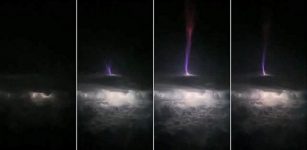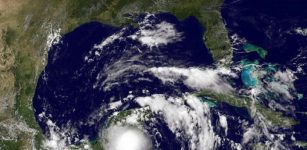Thousands Of Mysterious Ice Quakes Shake Antarctica At Night
Eddie Gonzales Jr. – MessageToEagle.com – Scientists investigating climate change on Antarctica’s McMurdo Ice Shelf have discovered a peculiar phenomenon that can shed new light on what’s causing the breakup of large ice shelves.
Seismometers have recorded hundreds of thousands of tiny ‘ice quakes’ that occur at night. It seems these mysterious ice quakes are caused by pools of partially melted ice expanding and freezing at night.
Antarctica. Credit: Public Domain
“In these areas we would record tens, hundreds, up to thousands of these per night,” said study co-author Douglas MacAyeal, a professor of geophysical sciences and renowned glaciologist who has been traveling to the Antarctic to study the behavior of ice and snow for decades. “It’s possible that seismometers may be a practical way for us to remotely monitor glacier melting.”
Climate change is causing the Antarctic to melt, but geologists are still trying to learn more about the process. The goal is to map how, where and why the ice is melting.
In 2002, the massive Larsen B ice shelf collapse took glaciologists by surprise, and it’s vital to understand these mechanisms so one can predict what will happen to the ice in the future.
See also:
Amasia (‘Pangaea Proxima’): Next Supercontinent Will Appear And Form One Continent On Our Planet
Why Are Some Antarctic Icebergs Green?
Huge Cavity In Antarctic Glacier Signals Rapid Decay
MacAyeal and the team were interested in the role of “quakes” on the floating ice shelves. They set up seismometers for 60 days during the melt season in two locations near seasonal meltwater lakes on the McMurdo Ice Shelf. One was drier; the other was slushier, with pools of melted water forming and refreezing. The wetter location, they found, was alive with seismic activity at night.
“In these ponds, there’s often a layer of ice on top of melted water below, like you see with a lake that’s only frozen on top,” MacAyeal explained. “As the temperature cools at night, the ice on the top contracts, and the water below expands as it undergoes freezing. This warps the top lid, until it finally breaks with a snap.”
Using seismometers, scientists from University of Chicago recorded hundreds of thousands of ‘ice quakes,’ a phenomenon that may help track glacier melting. Credit: Alison Banwell
The energy vibrates out into the surroundings, where it’s picked up by seismometers. Some of the cracks re-heal, but some do not, MacAyeal said in a press statement.
It may explain why icebergs actually break off more frequently during colder times of the year. “Perhaps this is happening at longer, slower scales,” MacAyeal said.
The discovery adds an important piece to our understanding of the physics and processes around melting ponds on ice shelves — especially if it can help researchers remotely keep track of Antarctic melting. “It may be very useful to add this to our other ways of monitoring ice,” MacAyeal said.
Written by Eddie Gonzales Jr. – MessageToEagle.com Staff Writer












